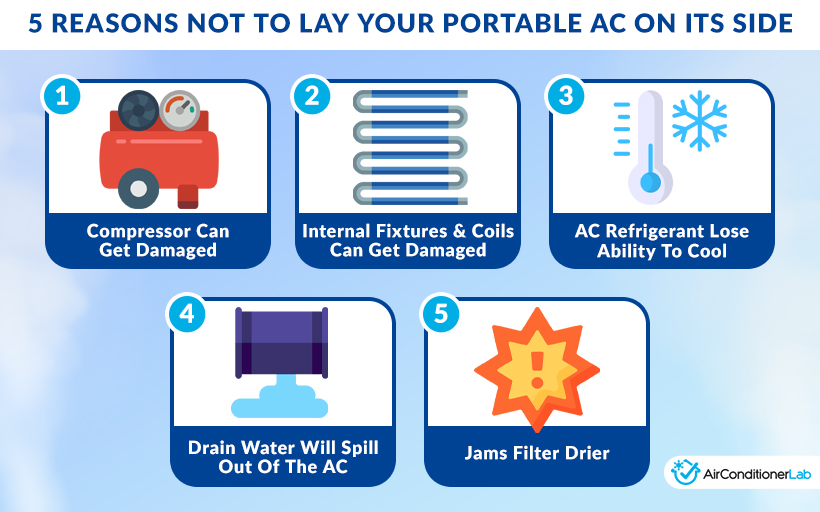When it comes to the comfort of your living space, air conditioning units play a pivotal role. They are designed to provide cool relief on sweltering summer days, transforming our homes into refreshing havens. One question that often arises among homeowners is whether it’s permissible to lay a portable air conditioner on its side. This query invites a deep dive into the mechanics of air conditioning, the engineering involved, and the potential repercussions of improper handling.
Understanding Portable Air Conditioners
Portable air conditioners are compact units engineered for mobility and efficiency. Unlike their larger counterparts, these air conditioners typically consist of a self-contained unit that can be maneuvered easily from one room to another. They work through a process of drawing in warm air, cooling it, and then expelling the chilled air into the room, with moisture being channeled out through a hose or container, depending on the model.
With this functionality comes the concern about positioning. In contrast to traditional window units or central air systems, portable units operate using a system that involves refrigerants and compressors. These components need to maintain specific orientations to function correctly. So, can you put an AC on its side? The short answer is no, but let’s elaborate on the reasoning behind this.
The Mechanics of Air Conditioners
To grasp why positioning matters, one must understand how air conditioners function. At the heart of the machine is the compressor, which compresses the refrigerant before it circulates throughout the system. This process creates pressure differentials that enable heat exchange. The refrigerant absorbs heat from indoors and releases it outside, facilitating the cooling effect.
When an air conditioner is laid on its side, gravity can disrupt the delicate balance required for the refrigerant to flow smoothly. This misalignment can lead to a multitude of issues.
- Refrigerant Flooding: If the unit is horizontal, the refrigerant may pool in places it should not, such as in the compressor. This can cause flooding, leading to inefficiency and even potential failure of the compressor over time.
- Damage to Internal Components: Air conditioners are designed to operate upright. When tipped, sensitive components may become dislodged or damaged, leading to costly repairs or the need for a replacement unit.
- Increased Wear and Tear: Operating the unit in a non-standard position can increase the strain on the compressor and other internal mechanisms, leading to premature wear and a shorter lifespan for the appliance.
Manufacturer Guidelines
It is essential to consult the manufacturer’s guidelines when handling any air conditioning unit. Most manufacturers explicitly state that portable air conditioners should always be kept upright. Some models may have specific instructions on transit and storage that outline allowable angles, but laying them flat is typically discouraged. Ignoring these recommendations could void warranties and lead to avoidable headaches.
What to Do Instead
If you find yourself in a situation with limited space or transportation concerns, consider alternative solutions. Instead of laying the air conditioner on its side, you can:
- Keep it Upright: Ensure the unit remains upright during transport and storage, which preserves its integrity and functionality.
- Utilize a Secure Carrier: If you need to move the unit, invest in a dolly or hand truck that allows for easy transport without compromising its position.
- Follow Manufacturer Instructions: For any unique scenarios, follow the manufacturer’s guidance dedicated to your air conditioner model, which will provide insights on handling and care.
Signs of Damage
If you suspect that your air conditioner has been improperly positioned, be vigilant for signs of distress. Unusual noises—such as grinding or rattling—can indicate mechanical issues. Additionally, if the unit fails to cool effectively or exhibits leaks, it may require professional evaluation.
Professional Help
Should you encounter any complications, consulting a certified technician is the best course of action. Professionals can diagnose the problem accurately and provide solutions tailored to your needs. They can also offer advice on preventative measures, ensuring the longevity and reliability of your air conditioning system.
Conclusion
In conclusion, portable air conditioners are efficient solutions for maintaining comfort in your home. However, understanding their operational guidelines is crucial. Laying the unit on its side can lead to catastrophic failures and a myriad of issues that could cost both time and money. Always prioritize the manufacturer’s instructions, maintain the unit’s upright position, and take preventative measures when handling your air conditioning system. By doing so, you ensure that you can enjoy cool breezes in the summer heat for many seasons to come.
